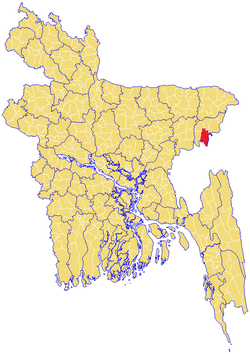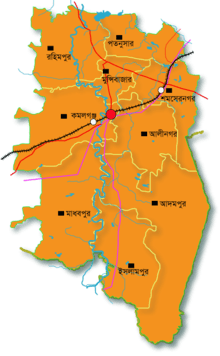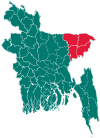Kamalganj Upazila
Kamalganj (Bengali: কমলগঞ্জ) is an Upazila of the Moulvibazar District[1] in the Division of Sylhet, Bangladesh.
Kamalganj কমলগঞ্জ | |
|---|---|
Upazila | |
 | |
| Country | |
| Division | Sylhet Division |
| District | Moulvibazar District |
| Government | |
| • MP (Maulvibazar-4) | Md. Abdus Shahid (Awami League) |
| • Upazila Chairman | Rafiqur Rahman (Awami League) |
| Area | |
| • Total | 485.26 km2 (187.36 sq mi) |
| Population | |
| • Total | 191,672 |
| • Density | 390/km2 (1,000/sq mi) |
| Demonym(s) | Kamalganji, Komolgonji, Khomolgoinji |
| Time zone | UTC+6 (BST) |
| Postal Code | 3220-30 |
| Website | kamolganj |
Etymology
There was a local zamindar by the name of Kinkar Nath Ray who appointed a naib by the name of Kamal Narayan in order to develop the land. Kamal established a ganj (treasured neighbourhood) named after himself. In 1922, Kamalganj was made a thana and in 1983, an upazila.[2]
History
Kamalganj was a part of the ancient Ita Kingdom founded by Raja Bhanu Narayan. The final raja of the Ita Kingdom, Raja Subid Narayan lost a battle in 1610 in which the region became under the rule of Khwaja Usman. However, this rule was short-lived after Mughal General Islam Khan I's attack in 1612.[3] The battle between the Mughal Empire and Khwaja Usman was held in Patanushar, Kamalganj. This led to the death of Afghan leader Khwaja Usman.[4]
A peasant rebellion led by Qasim Ali, Panchanan Singh, Baikuntha Sharma and Themba Singh was also held in the 1900s in Vanubal, Kamalganj.[5]
Demographics

As of the 1991 Bangladesh census, Kamalganj has a population of 191,672. Males constitute 50.98% of the population, and females 49.02%. This Upazila's eighteen up population is 102,877. Kamalganj has an average literacy rate of 28.6% (7+ years), compared to the national average of 32.4%.[6] Majority of the residents are Bengalis although there is a minority of indigenous peoples such as the Khasi, Manipuris, Bishnupriya Manipuris, Tripuris and Garos.[7]
Administration

Kamalganj has 9 Unions/Wards, 118 Mauzas/Mahallas, and 276 villages. The Unions are: Shamsher Nagar, Patanushar, Rahimpur, Munshi Bazar, Ali Nagar, Kamalganj, Adampur, Islampur, Madhabpur.
Economy and tourism
Kamalganj is home to many tourist attractions and natural geography. It contains many tea gardens and the Lawachara National Park. Other sites include the mausoleums of Shah Kala in Bhadair-Deul (near Shamshernagar Rail Station), Shah Ghayb (north of Bhanugach Rail Station) and Shah Ghazi Malik in Bhadair-Deul. The ruins of the Ita Kingdom can be found across Kamalganj. The forts of Khwaja Usman, his grave and false tomb can be found in Patanushar in the areas of Srisurya and Usmangarh.
Notable residents
- Chowdhury Gulam Akbar, writer, was born in Dargahpur village in 1921.[8]
- Surendra Kumar Sinha, 21st Chief Justice of Bangladesh
- Ashraf Hussain, poet, writer, researcher
- Khwaja Usman, Mughal opponent and Baro-Bhuyan chieftain
- Haji Anamul Haque Khasru, Former politician, Businessman and community activist. Donated and helped to build many organizations in Kamalganj Upazila and He was an organiser for distributing Karitas projects in Moulvibazar district.
- Mawlana Abdul Goni, Islamic activist and former leader of Muslim League
- Talukdar BB Mujaffar, Former revenue collector during British Rule
See also
- Upazilas of Bangladesh
- Districts of Bangladesh
- Divisions of Bangladesh
References
- Shah Abdul Wadud (2012). "Kamalganj Upazila". In Islam, Sirajul; Miah, Sajahan; Khanam, Mahfuza; Ahmed, Sabbir (eds.). Banglapedia: the National Encyclopedia of Bangladesh (Online ed.). Dhaka, Bangladesh: Banglapedia Trust, Asiatic Society of Bangladesh. ISBN 984-32-0576-6. OCLC 52727562. Retrieved 15 August 2020.
- "উপজেলা পটভূমি". Government of Bangladesh (in Bengali). Retrieved 24 September 2018.
- "Patabhumi". Zilla Parishad. Retrieved 24 April 2019.
- "Bhougolik Porichiti". Moulvibazar Gov. Retrieved 24 September 2018.
- "Itihash". Government of Bangladesh. Retrieved 24 September 2018.
- "Population Census Wing, BBS". Archived from the original on 2005-03-27. Retrieved November 10, 2006.
- "Aitihya". Government of Bangladesh (in Bengali). Retrieved 24 September 2018.
- Gibran, Soaib Ahmed (2012). "Akbar, Chowdhury Golam". In Islam, Sirajul; Jamal, Ahmed A. (eds.). Banglapedia: National Encyclopedia of Bangladesh (Second ed.). Asiatic Society of Bangladesh.
